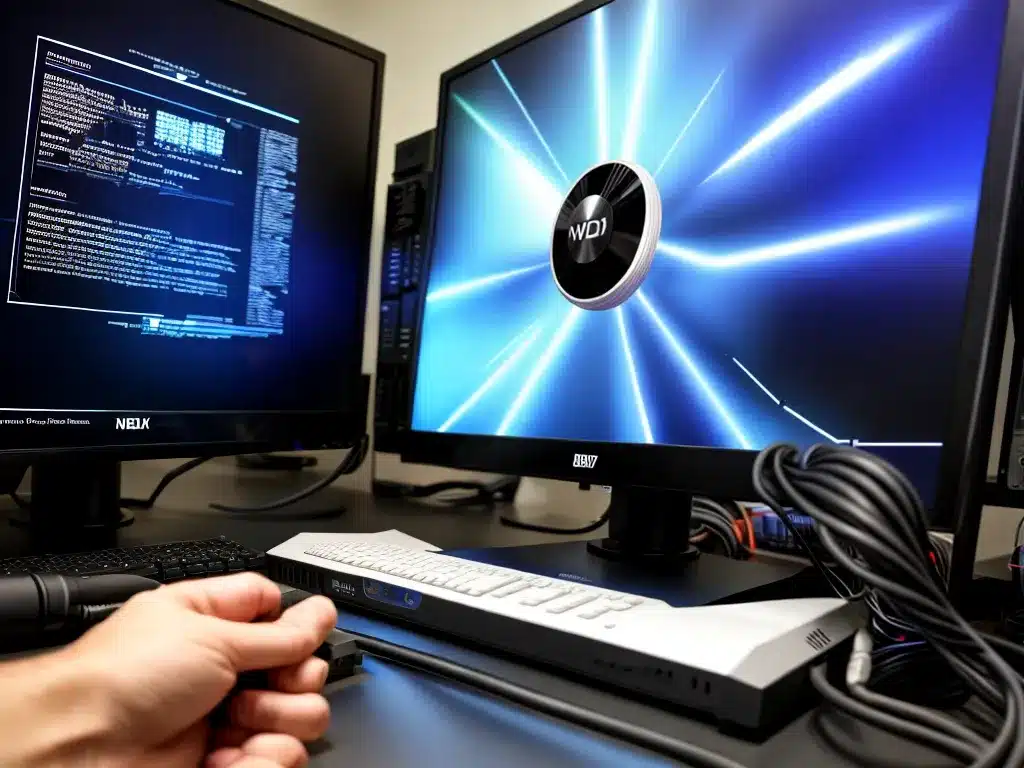Having no display on your monitor can be frustrating. However, with some patience and elbow grease, you can troubleshoot the issue and get your monitor working again. Here are some tips for troubleshooting your graphics card (GPU) and cables to fix a monitor with no display.
Check Your GPU Connection
The first thing to check is whether your graphics card is properly seated in the PCIe slot and connected to the power supply.
- Turn off your computer and unplug the power cable before opening up the case.
- Locate the graphics card in the PCIe slot. It will likely have fans on it and outputs for connecting a monitor.
- Check that it is fully seated in the PCIe slot. Reseat it by gently pressing it into the slot.
- Check the power connections. Most dedicated GPUs require extra power from the PSU. Make sure the power cable(s) are firmly plugged into the graphics card.
- Secure the graphics card with the PCIe bracket screw if it is loose.
- Reconnect the power cable and turn on your PC to see if the display works now.
Reseating the graphics card and ensuring a solid connection is the most common solution for a no display issue.
Try Your GPU in Another PCIe Slot
If reseating the GPU didn’t work, try moving it to another PCIe slot on your motherboard if one is available.
- Power down and unplug the PC.
- Remove the GPU from the current PCIe slot.
- Insert it into another PCIe slot, making sure it is fully seated.
- Connect the power cables and screw in the bracket.
- Boot up the PC and check if the display works now.
Using another PCIe slot can bypass issues with a dead slot. Just make sure the new slot supports the full x16 bandwidth of your graphics card.
Test Your GPU in Another Computer
If you have access to another desktop PC, try installing your graphics card in it as a test.
- Remove the GPU from your computer and install it in another desktop that has a compatible PCIe slot.
- Connect the power cables and boot up the test PC.
- Check if the monitor display works properly. This confirms whether the issue is with the GPU or something else in your original PC.
By testing the GPU in another system, you can isolate whether the card itself is faulty or whether something else in your PC is the culprit.
Try Integrated Graphics Instead
If your processor has integrated graphics, you can test using the motherboard video outputs instead of your graphics card.
- Remove the dedicated GPU from your motherboard.
- Connect your monitor video cable to the motherboard video output instead. Make sure your monitor is powered on.
- Boot up your PC. It should default to the integrated graphics.
- Check if you get a display signal. The graphics won’t be as good, but this verifies whether the GPU is faulty.
If the integrated graphics work, it points to an issue with your dedicated graphics card that will need further troubleshooting.
Reseat and Replace Display Cables
Loose display cables are another simple possible cause of no display.
- Reseat both ends of the display cable where it plugs into your GPU and monitor.
- Try connecting another cable if you have a spare, like HDMI, DisplayPort, or DVI.
- Test different video outputs on your GPU if available.
- Make sure the monitor input is set to the correct source.
If using a different display cable fixes your video signal, the original cable was faulty and needed replacing.
Update Graphics Drivers
Outdated graphics drivers can sometimes lead to blank screens or failed initialization.
- Enter Windows Safe Mode to boot with default graphics drivers. See if the display works then.
- Download the newest drivers for your GPU from the manufacturer website if needed.
- Use DDU (Display Driver Uninstaller) to fully remove existing drivers.
- Install the latest drivers and restart your PC.
Updating to the newest graphics drivers can fix compatibility issues that prevent a display signal.
Reset CMOS/BIOS Settings
Resetting your motherboard’s CMOS memory can clear any issues caused by incorrect BIOS settings.
- Locate the CMOS reset or clear jumper on your motherboard, often near the battery.
- Power down your PC and unplug power cable.
- Momentarily place the jumper cap over both CMOS pins.
- Remove jumper and reconnect power.
- Enter BIOS to load optimized defaults or reconfigure settings.
Resetting the CMOS will clear out any old GPU, display, or boot-related settings that may be causing problems.
Test Your GPU in Another System
If you have eliminated software factors, trying your GPU in another system can isolate a faulty graphics card.
- Remove the suspect GPU from your system.
- Install it in a friend’s PC with a compatible PCIe slot.
- Connect power cables and boot up test PC.
- Check if their monitor display works properly.
If the card fails to output video in another system, it is likely defective and needs RMA or replacement.
Conclusion
With some patience and step-by-step troubleshooting, you can identify and fix an absent monitor display caused by GPU or cable issues. Start with simple fixes like reseating connections, cables, and updating drivers. For hardware failures, swap in spare parts like another GPU or PCIe slot for isolation testing. Getting your monitor back up and running again is a rewarding feeling after methodical troubleshooting.













